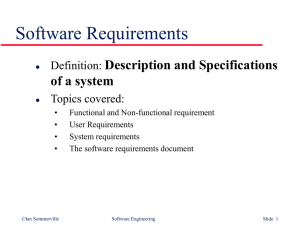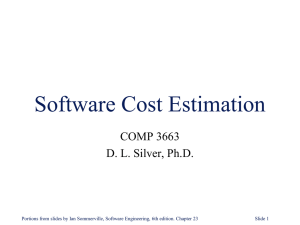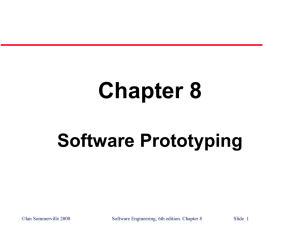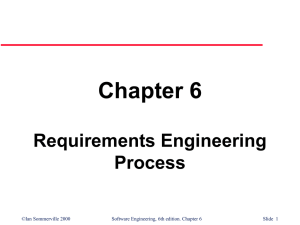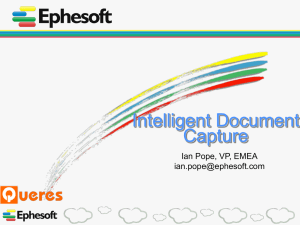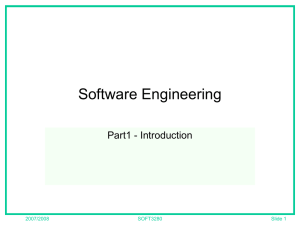ch05
advertisement
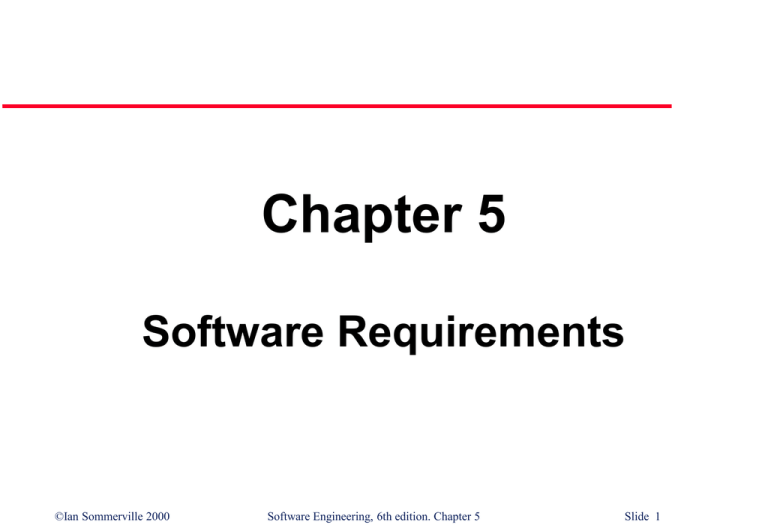
Chapter 5
Software Requirements
©Ian Sommerville 2000
Software Engineering, 6th edition. Chapter 5
Slide 1
Software Requirements
Descriptions and specifications of a system
©Ian Sommerville 2000
Software Engineering, 6th edition. Chapter 5
Slide 2
Objectives
To introduce the concepts of user and system
requirements
To describe functional and non-functional
requirements
To explain two techniques for describing system
requirements
To explain how software requirements may be
organised in a requirements document
©Ian Sommerville 2000
Software Engineering, 6th edition. Chapter 5
Slide 3
Topics covered
Functional and non-functional requirements
User requirements
System requirements
The software requirements document
©Ian Sommerville 2000
Software Engineering, 6th edition. Chapter 5
Slide 4
Requirements engineering
The process of establishing the services that the
customer requires from a system and the constraints
under which it operates and is developed
The requirements themselves are the descriptions of
the system services and constraints that are
generated during the requirements engineering
process
©Ian Sommerville 2000
Software Engineering, 6th edition. Chapter 5
Slide 5
What is a requirement?
It may range from a high-level abstract statement of
a service or of a system constraint to a detailed
mathematical functional specification
This is inevitable as requirements may serve a dual
function
•
•
•
May be the basis for a bid for a contract - therefore must be open to
interpretation
May be the basis for the contract itself - therefore must be defined in
detail
Both these statements may be called requirements
©Ian Sommerville 2000
Software Engineering, 6th edition. Chapter 5
Slide 6
Requirements abstraction (Davis)
“If a company wishes to let a contract for a large software development project, it must define its needs in a
sufficiently abstract way that a solution is not pre-defined. The requirements must be written so that several
contractors can bid for the contract, offering, perhaps, different ways of meeting the client organisation’s needs.
Once a contract has been awarded, the contractor must write a system definition for the client in more detail so
that the client understands and can validate what the software will do. Both of these documents may be called
the requirements document for the system.”
©Ian Sommerville 2000
Software Engineering, 6th edition. Chapter 5
Slide 7
Types of requirement
User requirements
•
System requirements
•
Statements in natural language plus diagrams of the services the
system provides and its operational constraints. Written for customers
A structured document setting out detailed descriptions of the system
services. Written as a contract between client and contractor
Software specification
•
A detailed software description which can serve as a basis for a
design or implementation. Written for developers
©Ian Sommerville 2000
Software Engineering, 6th edition. Chapter 5
Slide 8
Definitions and specifications
Requirements definition
1. The software must provide a means of repr esenting and
1. accessing external files created by other tools.
Requirements specification
1.1 The user should be provided with facilities to define the type of
1.2 external files.
1.2 Each external file type may have an associated tool which may be
1.2 applied to the file.
1.3 Each external file type may be represented as a specific icon on
1.2 the user’s display.
1.4 Facilities should be provided for the icon repr esenting an
1.2 external file type to be defined by the user.
1.5 When a user selects an icon repr esenting an external file, the
1.2 effect of that selection is to apply the tool associated with the type of
1.2 the external file to the file represented by the selected icon.
©Ian Sommerville 2000
Software Engineering, 6th edition. Chapter 5
Slide 9
Requirements readers
User requirements
Client managers
System end-users
Client engineers
Contractor managers
System architects
System requirements
System end-users
Client engineers
System architects
Software developers
Software design
specification
©Ian Sommerville 2000
Client engineers (perhaps)
System architects
Software developers
Software Engineering, 6th edition. Chapter 5
Slide 10
Functional and non-functional requirements
Functional requirements
•
Non-functional requirements
•
Statements of services the system should provide, how the system
should react to particular inputs and how the system should behave
in particular situations.
constraints on the services or functions offered by the system such as
timing constraints, constraints on the development process,
standards, etc.
Domain requirements
•
Requirements that come from the application domain of the system
and that reflect characteristics of that domain
©Ian Sommerville 2000
Software Engineering, 6th edition. Chapter 5
Slide 11
Functional requirements
Describe functionality or system services
Depend on the type of software, expected users and
the type of system where the software is used
Functional user requirements may be high-level
statements of what the system should do but
functional system requirements should describe the
system services in detail
©Ian Sommerville 2000
Software Engineering, 6th edition. Chapter 5
Slide 12
Examples of functional requirements
The user shall be able to search either all of the
initial set of databases or select a subset from it.
The system shall provide appropriate viewers for the
user to read documents in the document store.
Every order shall be allocated a unique identifier
(ORDER_ID) which the user shall be able to copy to
the account’s permanent storage area.
©Ian Sommerville 2000
Software Engineering, 6th edition. Chapter 5
Slide 13
Requirements imprecision
Problems arise when requirements are not precisely
stated
Ambiguous requirements may be interpreted in
different ways by developers and users
Consider the term ‘appropriate viewers’
•
•
User intention - special purpose viewer for each different document
type
Developer interpretation - Provide a text viewer that shows the
contents of the document
©Ian Sommerville 2000
Software Engineering, 6th edition. Chapter 5
Slide 14
Requirements completeness and consistency
In principle requirements should be both complete
and consistent
Complete
•
Consistent
•
They should include descriptions of all facilities required
There should be no conflicts or contradictions in the descriptions of
the system facilities
In practice, it is impossible to produce a complete
and consistent requirements document
©Ian Sommerville 2000
Software Engineering, 6th edition. Chapter 5
Slide 15
Non-functional requirements
Define system properties and constraints e.g.
reliability, response time and storage requirements.
Constraints are I/O device capability, system
representations, etc.
Process requirements may also be specified
mandating a particular CASE system, programming
language or development method
Non-functional requirements may be more critical
than functional requirements. If these are not met,
the system is useless
©Ian Sommerville 2000
Software Engineering, 6th edition. Chapter 5
Slide 16
Non-functional classifications
Product requirements
•
Organisational requirements
•
Requirements which specify that the delivered product must behave
in a particular way e.g. execution speed, reliability, etc.
Requirements which are a consequence of organisational policies
and procedures e.g. process standards used, implementation
requirements, etc.
External requirements
•
Requirements which arise from factors which are external to the
system and its development process e.g. interoperability
requirements, legislative requirements, etc.
©Ian Sommerville 2000
Software Engineering, 6th edition. Chapter 5
Slide 17
Non-functional requirement types
Non-functional
requir ements
Product
requir ements
Ef ficiency
requir ements
Reliability
requir ements
Usability
requirements
Performance
requirements
Or ganizational
requir ements
Portability
requirements
Delivery
requirements
Interoperability
requirements
Implementation
requir ements
Space
requir ements
©Ian Sommerville 2000
External
requirements
Software Engineering, 6th edition. Chapter 5
Ethical
requirements
Standards
requirements
Legislative
requirements
Privacy
requirements
Safety
requirements
Slide 18
Non-functional requirements examples
Product requirement
•
Organisational requirement
•
4.C.8 It shall be possible for all necessary communication between
the APSE and the user to be expressed in the standard Ada character
set
9.3.2 The system development process and deliverable documents
shall conform to the process and deliverables defined in XYZCo-SPSTAN-95
External requirement
•
7.6.5 The system shall not disclose any personal information about
customers apart from their name and reference number to the
operators of the system
©Ian Sommerville 2000
Software Engineering, 6th edition. Chapter 5
Slide 19
Goals and requirements
Non-functional requirements may be very difficult to
state precisely and imprecise requirements may be
difficult to verify.
Goal
•
Verifiable non-functional requirement
•
A general intention of the user such as ease of use
A statement using some measure that can be objectively tested
Goals are helpful to developers as they convey the
intentions of the system users
©Ian Sommerville 2000
Software Engineering, 6th edition. Chapter 5
Slide 20
Examples
A system goal
•
The system should be easy to use by experienced controllers and
should be organised in such a way that user errors are minimised.
A verifiable non-functional requirement
•
Experienced controllers shall be able to use all the system functions
after a total of two hours training. After this training, the average
number of errors made by experienced users shall not exceed two
per day.
©Ian Sommerville 2000
Software Engineering, 6th edition. Chapter 5
Slide 21
Requirements measures
Pro perty
Speed
Size
Eas e of u se
Rel iabi li ty
Rob u st ness
P ortabi li ty
©Ian Sommerville 2000
Meas ure
P ro cess ed t rans acti o ns /s econ d
User/ Event res po n se ti me
Screen refresh t ime
K By tes
Nu mb er o f RAM ch ip s
Train in g time
Nu mb er o f h elp frames
Mean ti me t o failu re
P ro b ab il ity o f u n av ailab ili ty
Rat e of failu re o ccu rren ce
Av ai lab i lit y
Time to rest art aft er failu re
P ercent ag e o f event s caus in g fail ure
P ro b ab il ity o f d ata co rru pt io n on fail ure
P ercent ag e o f targ et d ep end ent st at ement s
Nu mb er o f t arget sy st ems
Software Engineering, 6th edition. Chapter 5
Slide 22
Requirements interaction
Conflicts between different non-functional
requirements are common in complex systems
Spacecraft system
•
•
•
To minimise weight, the number of separate chips in the system
should be minimised
To minimise power consumption, lower power chips should be used
However, using low power chips may mean that more chips have to
be used. Which is the most critical requirement?
©Ian Sommerville 2000
Software Engineering, 6th edition. Chapter 5
Slide 23
Domain requirements
Derived from the application domain and describe
system characterisics and features that reflect the
domain
May be new functional requirements, constraints on
existing requirements or define specific computations
If domain requirements are not satisfied, the system
may be unworkable
©Ian Sommerville 2000
Software Engineering, 6th edition. Chapter 5
Slide 24
Library system domain requirements
There shall be a standard user interface to all
databases which shall be based on the Z39.50
standard.
Because of copyright restrictions, some documents
must be deleted immediately on arrival. Depending
on the user’s requirements, these documents will
either be printed locally on the system server for
manually forwarding to the user or routed to a
network printer.
©Ian Sommerville 2000
Software Engineering, 6th edition. Chapter 5
Slide 25
Train protection system
The deceleration of the train shall be computed
as:
•
Dtrain = Dcontrol + Dgradient
where Dgradient is 9.81ms2 * compensated
gradient/alpha and where the values of 9.81ms2
/alpha are known for different types of train.
©Ian Sommerville 2000
Software Engineering, 6th edition. Chapter 5
Slide 26
Domain requirements problems
Understandability
•
•
Requirements are expressed in the language of the application
domain
This is often not understood by software engineers developing the
system
Implicitness
•
Domain specialists understand the area so well that they do not think
of making the domain requirements explicit
©Ian Sommerville 2000
Software Engineering, 6th edition. Chapter 5
Slide 27
User requirements
Should describe functional and non-functional
requirements so that they are understandable by
system users who don’t have detailed technical
knowledge
User requirements are defined using natural
language, tables and diagrams
©Ian Sommerville 2000
Software Engineering, 6th edition. Chapter 5
Slide 28
Problems with natural language
Lack of clarity
•
Requirements confusion
•
Precision is difficult without making the document difficult to read
Functional and non-functional requirements tend to be mixed-up
Requirements amalgamation
•
Several different requirements may be expressed together
©Ian Sommerville 2000
Software Engineering, 6th edition. Chapter 5
Slide 29
Database requirement
4.A.5 The database shall support the generation and control of
configuration objects; that is, objects which are themselves groupings
of other objects in the database. The configuration control facilities
shall allow access to the objects in a version group by the use of an
incomplete name.
©Ian Sommerville 2000
Software Engineering, 6th edition. Chapter 5
Slide 30
Editor grid requirement
2.6 Grid facilities To assist in the positioning of entities on a diagram,
the user may turn on a grid in either centimetres or inches, via an
option on the control panel. Initially, the grid is off. The grid may be
turned on and off at any time during an editing session and can be
toggled between inches and centimetres at any time. A grid option
will be provided on the reduce-to-fit view but the number of grid
lines shown will be reduced to avoid filling the smaller diagram
with grid lines.
©Ian Sommerville 2000
Software Engineering, 6th edition. Chapter 5
Slide 31
Requirement problems
Database requirements includes both conceptual
and detailed information
•
•
Describes the concept of configuration control facilities
Includes the detail that objects may be accessed using an incomplete
name
Grid requirement mixes three different kinds of
requirement
•
•
•
Conceptual functional requirement (the need for a grid)
Non-functional requirement (grid units)
Non-functional UI requirement (grid switching)
©Ian Sommerville 2000
Software Engineering, 6th edition. Chapter 5
Slide 32
Structured presentation
GriFacilities
1 The editor shall provide a grid facility where a matrix
of horizontal and vertical lines provide a background
to the editor window. This grid shall be a passive grid
where the alignment of entities is the user's responsibility.
Rationale: A grid helps the user to create a tidy diagram
with well-spaced entities. Although an active grid, where
entities 'snap-to' grid lines can be useful, the positioning is
imprecise. The user is the best person to decide where
entities should be positioned.
Specification: ECLIPSE/WS/Tools/DE/FS Section 5.6
©Ian Sommerville 2000
Software Engineering, 6th edition. Chapter 5
Slide 33
Detailed user requirement
3.5.1 Adding nodes to a design
3.5.1.1 The editor shall provide a facility for users to add nodes of a specified
type to their design.
3.5.1.2 The sequence of actions to add a node should be as follows:
1. The user should select the type of node to be added.
2. The user should move the cursor to the approximate node position in the
diagram and indicate that the node symbol should be added at that
point.
3. The user should then drag the node symbol to its final position.
Rationale: The user is the best person to decide where to position a node on
the diagram. This approach gives the user direct control over node
type selection and positioning.
Specification: ECLIPSE/WS/Tools/DE/FS. Section 3.5.1
©Ian Sommerville 2000
Software Engineering, 6th edition. Chapter 5
Slide 34
Guidelines for writing requirements
Invent a standard format and use it for all
requirements
Use language in a consistent way. Use shall for
mandatory requirements, should for desirable
requirements
Use text highlighting to identify key parts of the
requirement
Avoid the use of computer jargon
©Ian Sommerville 2000
Software Engineering, 6th edition. Chapter 5
Slide 35
System requirements
More detailed specifications of user requirements
Serve as a basis for designing the system
May be used as part of the system contract
System requirements may be expressed using
system models discussed in Chapter 7
©Ian Sommerville 2000
Software Engineering, 6th edition. Chapter 5
Slide 36
Requirements and design
In principle, requirements should state what the
system should do and the design should describe
how it does this
In practice, requirements and design are inseparable
•
•
•
A system architecture may be designed to structure the requirements
The system may inter-operate with other systems that generate
design requirements
The use of a specific design may be a domain requirement
©Ian Sommerville 2000
Software Engineering, 6th edition. Chapter 5
Slide 37
Problems with NL specification
Ambiguity
•
Over-flexibility
•
The readers and writers of the requirement must interpret the same
words in the same way. NL is naturally ambiguous so this is very
difficult
The same thing may be said in a number of different ways in the
specification
Lack of modularisation
•
NL structures are inadequate to structure system requirements
©Ian Sommerville 2000
Software Engineering, 6th edition. Chapter 5
Slide 38
Alternatives to NL specification
Notation
Structured
natural
language
Design
description
languages
Graphical
notations
Mathematical
specifications
©Ian Sommerville 2000
Description
This approach depends on defining standard forms or
templates to express the requirements specification.
This approach uses a language like a programming
language but with more abstract features to specify the
requirements by defining an operational model of the
system.
A graphical language, supplemented by text annotations is
used to define the functional requirements for the system.
An early example of such a graphical language was SADT
(Ross, 1977; Schoman and Ross, 1977). More recently,
use-case descriptions (Jacobsen, Christerson et al., 1993)
have been used. I discuss these in the following chapter.
These are notations based on mathematical concepts
such as finite-state machines or sets. These unambiguous
specifications reduce the arguments between customer
and contractor about system functionality. However, most
customers don’t understand formal specifications and are
reluctant to accept it as a system contract. I discuss formal
specification in Chapter 9.
Software Engineering, 6th edition. Chapter 5
Slide 39
Structured language specifications
A limited form of natural language may be used to
express requirements
This removes some of the problems resulting from
ambiguity and flexibility and imposes a degree of
uniformity on a specification
Often bast supported using a forms-based approach
©Ian Sommerville 2000
Software Engineering, 6th edition. Chapter 5
Slide 40
Form-based specifications
Definition of the function or entity
Description of inputs and where they come from
Description of outputs and where they go to
Indication of other entities required
Pre and post conditions (if appropriate)
The side effects (if any)
©Ian Sommerville 2000
Software Engineering, 6th edition. Chapter 5
Slide 41
Form-based node specification
ECLIP SE/W orks tati on/Tool s/ DE/FS/ 3.5.1
Function
Add node
Des cripti on
Addsa node to an exi st ing des ign. The user s el ects t he type of node, and it s posi ti on.
When added to the des ign, the node becomes
the current select ion. The user choos es the node posi ti on by
movi ng t he cursor t o the area where t he node is added.
I nputs Node type, Node pos it ion, Des ign ident ifi er.
Source
Node type and Node pos it ion are i nput by the us er, Desi gn i denti fier from the databas e.
Outputs
Des ign ident ifi er.
Des ti nati on
operati on.
The des ign databas e. The des ign is committ ed t o the database on compl et ion of the
Requires
Des ign graph rooted at input des ign ident ifi er.
Pre-conditi on
The des ign is open and dis pl ayed on the user's s creen.
Pos t-condi tion
at t he given posi tion.
The des ign is unchanged apart from t he
addit ion of a node of the specified t ype
Side-ef fects
None
Def init ion: ECLIPSE/W or ks tati on/ Tools /DE/RD/3.5.1
©Ian Sommerville 2000
Software Engineering, 6th edition. Chapter 5
Slide 42
PDL-based requirements definition
Requirements may be defined operationally using a language
like a programming language but with more flexibility of
expression
Most appropriate in two situations
•
•
Where an operation is specified as a sequence of actions and the
order is important
When hardware and software interfaces have to be specified
Disadvantages are
•
•
The PDL may not be sufficiently expressive to define domain
concepts
The specification will be taken as a design rather than a specification
©Ian Sommerville 2000
Software Engineering, 6th edition. Chapter 5
Slide 43
Part of an ATM specification
class ATM {
// declarations here
public static void main (String args[]) throws InvalidCard {
try {
thisCard.read () ; // may throw InvalidCard exception
pin = KeyPad.readPin () ; attempts = 1 ;
while ( !thisCard.pin.equals (pin) & attempts < 4 )
{
pin = KeyPad.readPin () ; attempts = attempts + 1 ;
}
if (!thisCard.pin.equals (pin))
throw new InvalidCard ("Bad PIN");
thisBalance = thisCard.getBalance () ;
do { Screen.prompt (" Please select a service ") ;
service = Screen.touchKey () ;
switch (service) {
case Services.withdrawalWithReceipt:
receiptRequired = true ;
©Ian Sommerville 2000
Software Engineering, 6th edition. Chapter 5
Slide 44
PDL disadvantages
PDL may not be sufficiently expressive to express
the system functionality in an understandable way
Notation is only understandable to people with
programming language knowledge
The requirement may be taken as a design
specification rather than a model to help understand
the system
©Ian Sommerville 2000
Software Engineering, 6th edition. Chapter 5
Slide 45
Interface specification
Most systems must operate with other systems and
the operating interfaces must be specified as part of
the requirements
Three types of interface may have to be defined
•
•
•
Procedural interfaces
Data structures that are exchanged
Data representations
Formal notations are an effective technique for
interface specification
©Ian Sommerville 2000
Software Engineering, 6th edition. Chapter 5
Slide 46
PDL interface description
interface PrintServer {
// defines an abstract printer server
// requires: interface Printer, interface PrintDoc
// provides: initialize, print, displayPrintQueue, cancelPrintJob, switchPrinter
void initialize ( Printer p ) ;
void print ( Printer p, PrintDoc d ) ;
void displayPrintQueue ( Printer p ) ;
void cancelPrintJob (Printer p, PrintDoc d) ;
void switchPrinter (Printer p1, Printer p2, PrintDoc d) ;
} //PrintServer
©Ian Sommerville 2000
Software Engineering, 6th edition. Chapter 5
Slide 47
The requirements document
The requirements document is the official statement
of what is required of the system developers
Should include both a definition and a specification
of requirements
It is NOT a design document. As far as possible, it
should set of WHAT the system should do rather
than HOW it should do it
©Ian Sommerville 2000
Software Engineering, 6th edition. Chapter 5
Slide 48
System customers
Specify the requirements and
read them to check that they
meet their needs. They
specify changes to the
requirements
Managers
Use the requirements
document to plan a bid for
the system and to plan the
system development process
System engineers
Use the requirements to
understand what system is to
be developed
System test
engineers
System
maintenance
engineers
Use the requirements to
develop validation tests for
the system
Use the requirements to help
understand the system and
the relationships between its
parts
Users of a
requirements
document
Requirements document requirements
Specify external system behaviour
Specify implementation constraints
Easy to change
Serve as reference tool for maintenance
Record forethought about the life cycle of the system
i.e. predict changes
Characterise responses to unexpected events
©Ian Sommerville 2000
Software Engineering, 6th edition. Chapter 5
Slide 50
IEEE requirements standard
Introduction
General description
Specific requirements
Appendices
Index
This is a generic structure that must be instantiated
for specific systems
©Ian Sommerville 2000
Software Engineering, 6th edition. Chapter 5
Slide 51
Requirements document structure
Introduction
Glossary
User requirements definition
System architecture
System requirements specification
System models
System evolution
Appendices
Index
©Ian Sommerville 2000
Software Engineering, 6th edition. Chapter 5
Slide 52
Key points
Requirements set out what the system should do
and define constraints on its operation and
implementation
Functional requirements set out services the system
should provide
Non-functional requirements constrain the system
being developed or the development process
User requirements are high-level statements of what
the system should do
©Ian Sommerville 2000
Software Engineering, 6th edition. Chapter 5
Slide 53
Key points
User requirements should be written in natural
language, tables and diagrams
System requirements are intended to communicate
the functions that the system should provide
System requirements may be written in structured
natural language, a PDL or in a formal language
A software requirements document is an agreed
statement of the system requirements
©Ian Sommerville 2000
Software Engineering, 6th edition. Chapter 5
Slide 54


